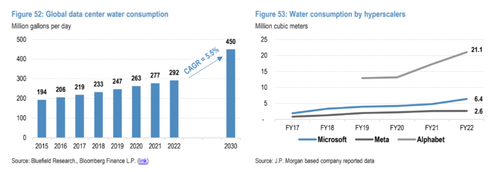Wall Street banks are in a frenzy over "The Next AI Trade," piling into the 'Powering up America' investment themes, whether that's power grid companies, commodities, such as copper, gold, silver, and uranium, and artificial intelligence chipmakers, to accommodate the explosion of generative artificial intelligence data centers anticipated nationwide through the end of the decade and beyond.
JPMorgan's Asia Pacific Equity Research desk is the latest bank to jump on AI trade in a note titled "Deep Dive into Power, Cooling, Electric Grid and ESG implications."
Focusing on AI data center power consumption is too repetitive at this point, considering we've laid it all out on a silver platter for premium ZH subs in the "The Next AI Trade" and "The Next AI Trade Just Hit An All-Time High."
As well as this real-world example...
Even Blackstone Chief Executive Officer Steve Schwarzman and BlackRock Chairman and Chief Executive Larry Fink have jumped onto the power grid and AI investment theme as there is plenty of upside in the years ahead - unless AI demand doesn't shit the bed.
Back to JPM's note, authored by analyst William Yang and his team, which near the end explained, "While data centers have been scrutinized for heavy electricity use, the water intensive nature of their operations has been comparatively overlooked."
Citing data from Bluefield Research, Yang said total water consumption by global data centers (including on-site cooling and off-site power generation) has grown 6% annually from 2017 to 2022. He said by 2030, water consumption could jump to 450 million gallons per day. To put this in perspective, that's 681 Olympic-sized pools of fresh water that will be needed each day to cool global data centers in about 4.5 years.
"By 2027, the same authors suggest that global AI demand may be accountable for 4.2 – 6.6 billion cubic meters of water withdrawal, more than the total annual water withdrawal of half of the United Kingdom when taking account of the combined scope 1 and scope 2 operational water withdrawal," Yang pointed out.
He said the immense water demand from data centers in areas where water resources are scarce could spark "increased competition can strain water availability, even causing data center closures."
Here are the various ways to cool data centers via water:
Much of the water usage at data centers is "because millions of gallons of water each day are evaporated in cooling systems designed to off-load server heat," the analysts said.
We'd love to know where the critics of crypto miners are now, as AI data centers are set to consume massive amounts of power and water.
Are any NGOs or Greta going to protest AI data centers? We doubt.
Wall Street banks are in a frenzy over "The Next AI Trade," piling into the 'Powering up America' investment themes, whether that's power grid companies, commodities, such as copper, gold, silver, and uranium, and artificial intelligence chipmakers, to accommodate the explosion of generative artificial intelligence data centers anticipated nationwide through the end of the decade and beyond.
JPMorgan's Asia Pacific Equity Research desk is the latest bank to jump on AI trade in a note titled "Deep Dive into Power, Cooling, Electric Grid and ESG implications."
Focusing on AI data center power consumption is too repetitive at this point, considering we've laid it all out on a silver platter for premium ZH subs in the "The Next AI Trade" and "The Next AI Trade Just Hit An All-Time High."
As well as this real-world example...
Even Blackstone Chief Executive Officer Steve Schwarzman and BlackRock Chairman and Chief Executive Larry Fink have jumped onto the power grid and AI investment theme as there is plenty of upside in the years ahead - unless AI demand doesn't shit the bed.
Back to JPM's note, authored by analyst William Yang and his team, which near the end explained, "While data centers have been scrutinized for heavy electricity use, the water intensive nature of their operations has been comparatively overlooked."
Citing data from Bluefield Research, Yang said total water consumption by global data centers (including on-site cooling and off-site power generation) has grown 6% annually from 2017 to 2022. He said by 2030, water consumption could jump to 450 million gallons per day. To put this in perspective, that's 681 Olympic-sized pools of fresh water that will be needed each day to cool global data centers in about 4.5 years.
"By 2027, the same authors suggest that global AI demand may be accountable for 4.2 – 6.6 billion cubic meters of water withdrawal, more than the total annual water withdrawal of half of the United Kingdom when taking account of the combined scope 1 and scope 2 operational water withdrawal," Yang pointed out.
He said the immense water demand from data centers in areas where water resources are scarce could spark "increased competition can strain water availability, even causing data center closures."
Here are the various ways to cool data centers via water:
Much of the water usage at data centers is "because millions of gallons of water each day are evaporated in cooling systems designed to off-load server heat," the analysts said.
We'd love to know where the critics of crypto miners are now, as AI data centers are set to consume massive amounts of power and water.
Are any NGOs or Greta going to protest AI data centers? We doubt.



